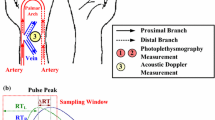Abstract
Detecting lower limb peripheral vascular occlusive disease (PVOD) early is important for patients to prevent disabling claudication, ischaemic rest pain and gangrene. According to previous research, the pulse timing and shape distortion characteristics of photoplethysmography (PPG) signals tend to increase with disease severity and calibrated amplitude decreases with vascular diseases. However, this is not a reliable method of evaluating the condition of PVOD because of noise effect. In this paper, an adaptive network-based fuzzy inference system (ANFIS) is proposed to assess lower limb PVOD based on PPG signals. PPG signals are non-invasively recorded from the right and left sides at the big toe sites from twenty subjects, including normal condition (Nor), lower-grade disease (LG), and higher-grade disease (HG) groups. The number of each group is 10, 8 and 2 respectively, and the ages ranged from 24 to 65 years. With the time-domain technique, the parameters for the absolute bilateral differences (right-to-left side of foot) in pulse delay and amplitude were extracted for analyzing ANFIS. The results indicated that ANFIS based on three timing parameters base bilateral differences, including ΔPTTf and ΔPTTp, and ΔRT has a high rate and noise tolerance of PVOD assessment.





Similar content being viewed by others
References
Yoon, Y., Cho, J. H., and Yoon, G., Non-constrained blood pressure monitoring using ECG and PPG for personal healthcare. J. Med. Syst. 33(4):261–266, 2009.
Übeyli, E. D., Cvetkovic, D., and Cosic, I., AR spectral analysis technique for human PPG, ECG and EEG signals. J. Med. Syst. 32(3):201–206, 2008.
Jago, J. R., and Murray, A., Repeatability of peripheral pulse measurement on ears, fingers, and toes using photoelectric plethysmography. Clin. Phys. Physiol. Meas. 9:319–329, 1988.
Allen, J., and Murray, A., Variability of photoplethysmography peripheral pulse measurements at the ears, thumbs, and toes. IEE Proc. Meas. Technol. 147:403–407, 2000.
Allen, J., and Murray, A., Age-related changes in the characteristics of the photoplethysmographic pulse shape at various body sites. Physiol. Meas. 24:297–307, 2003.
Oliva, I., Ipser, J., Roztocil, K., and Guttenbergerova, K., Fourier analysis of the pulse wave in obliterating arteriosclerosis. VASA 5:95–100, 1976.
Sherebrin, M. H., and Sherebrin, R. Z., Frequency-analysis of the peripheral pulse-wave detected in the finger with photoplethysmography. IEEE Trans. Biomed. Eng. 37:313–317, 1990.
Murray, W. B., and Foster, P. A., The peripheral pulse wave: Information overlooked. J. Clin. Mon. 12:365–377, 1996.
Nitzan, M., Khonokh, B., and Slovik, Y., The difference in pulse transit time to the toe and figure measured by photoplethysmography. Physiol. Meas. 23:85–93, 2002.
Allen, J., and Murray, A., Age-related changes in peripheral pulse timing characteristics at the ears, thumbs, and toes. J. Hum. Hypertens. 16:711–717, 2002.
Allen, J., Photoplethysmography and its application in clinical physiological measurement. Physiol. Meas. 28:1–39, 2007.
Allen, J., Oates, C. P., Lees, T. A., and Murray, A., Photoplethysmography detection of lower limb peripheral arterial occlusive disease: A comparison of pulse timing, amplitude and shape characteristics. Physiol. Meas. 26:811–821, 2005.
Stefanovska, A., Bracic, M., and Kvernmo, H. D., Wavelet analysis of oscillations in the peripheral blood circulation measured by laser Doppler technique. IEEE Trans. Biomed. Eng. 46:1230–1239, 1999.
Weng, J., Knoop, P., Hornberger, C., and Konecny, E., Appling neural network techniques to photoplethysmographic pulse shape analysis. Biomed. Techniques 43:92–93, 1998.
Allen, J., and Murray, A., Modeling the relationship between peripheral blood pressure and blood volume pulses using linear and neural network system identification techniques. Physiol. Meas. 20:369–377, 1999.
Sun, C. T., Rule-base structure identification in a adaptive-network-based fuzzy inference system. IEEE Trans. Fuzzy Syst. 2(1):64–73, 1994.
Lin, C. T., and Juang, C. F., An adaptive neural fuzzy filter and its applications. IEEE Trans. Syst. Man Cybernet. 27(4):635–656, 2001.
Rusu, P., Petriu, E. M., Whalen, T. E., Cornell, A., and Spoelder, H. J. W., Behavior-based neuro-fuzzy controller for mobile robot navigation. IEEE Trans. Instrument. Meas. 52(4):1335–1340, 2003.
Kuo, C. L., Design of an adaptive fuzzy sliding-mode controller for chaos synchronization. Int. J. Nonlinear Sci. Num. Simul. 8(4):631–636, 2007.
Allen, J., Overbeck, K., Nath, A. F., Murray, A., and Stansby, G., A prospective comparison of bilateral photoplethysmography versus the ankle-brachial pressure index for detecting and quantifying lower limb peripheral arterial disease. J. Vasc. Surg. 47(4):794–802, 2008.
Lin, C. H., Wu, C. H., and Huang, P. Z., Grey clustering analysis for incipient fault diagnosis in oil-immersed transformers. Expert Systems Appl. 36(2):1371–1379, 2009.
Huang, Y. C., A new data mining approach to dissolved gas analysis of oil-insulated power appatatus. IEEE Trans. Power Deliv. 18(4):1257–1261, 2003.
Acknowledgment
The author would like to thank clinician Dr. Chian-Ming Lee for providing his valuable suggestion and help on experiments.
Author information
Authors and Affiliations
Corresponding author
Rights and permissions
About this article
Cite this article
Du, YC., Lin, CH. Adaptive Network-based Fuzzy Inference System for Assessment of Lower Limb Peripheral Vascular Occlusive Disease. J Med Syst 36, 301–310 (2012). https://doi.org/10.1007/s10916-010-9476-1
Received:
Accepted:
Published:
Issue Date:
DOI: https://doi.org/10.1007/s10916-010-9476-1




